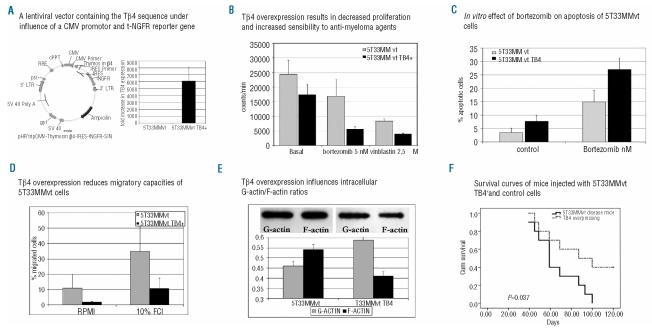Figure 2.
(A) Schematic representation of the modified lentiviral transfer plasmid and results of RT-PCR and qRT-PCR indicating the presence of the inserted Tβ4 gene in cultured 5T33MMvtTβ4+ cells. (B) 3H thymidine uptake revealed a decreased DNA synthesis rate in 5T33MMvtTβ4+ cells compared to wild-type cells. Incubation with the anti-MM agent bortezomib (5 nM) or the micro-tubuli inhibitor vinblastine (2,5 μM) had significantly (P<0.001) stronger effects on 5T33MMvtTβ4+ cells than on control cells. A similar observation was made in apoptosis studies (C), where 5nM of bortezomib resulted in a significantly (P<0.05) increased apoptotic cell population after 18h incubation. (D) The effects of Tβ4 overexpression on migration of 5T33MMvt cells: using 10% fetal calf serum as chemo-attractant, only 10.8% (SD 6.6%) of 5T33MMvtTβ4+ cells migrated compared to 34.7% (SD 15.9%) of the control 5T33MMvt cells (P<0.05). (E) (Upper) The F-actin and G-actin bands of 5T33MMvt and 5T33MMvtTβ4+ cells. The graph illustrates the ratios of quantified F-actin and G-actin. In 5T33MMt cells actin is present in its polymerized form, whereas Tβ4 overexpression results in decreased F-actin formation and a greater pool of G-actin. (F) C57Bl/KaLwRij mice were injected with 5T33MMvt wild-type and 5T33MMvtTβ4+ cells. Kaplan-Meier analysis showed a significantly different survival between these 2 groups with a mean survival of mice injected with 5T33MMvt wild type of 65.9 days (SD 6.6 days), compared to 88.9 days (SD 9.3 days) for mice injected with 5T33MMvtTβ4+ cells. (P<0.05). LTR: long terminal repeat; gag: frame-shifted gag gene; RRE: rev-responsive element; CMV: cytomegalovirus promotor trip: central polypurine tract + termination sequence; Ires: internal ribosomal entry site; tNGFR: truncated form of the nerve growth factor receptor.

